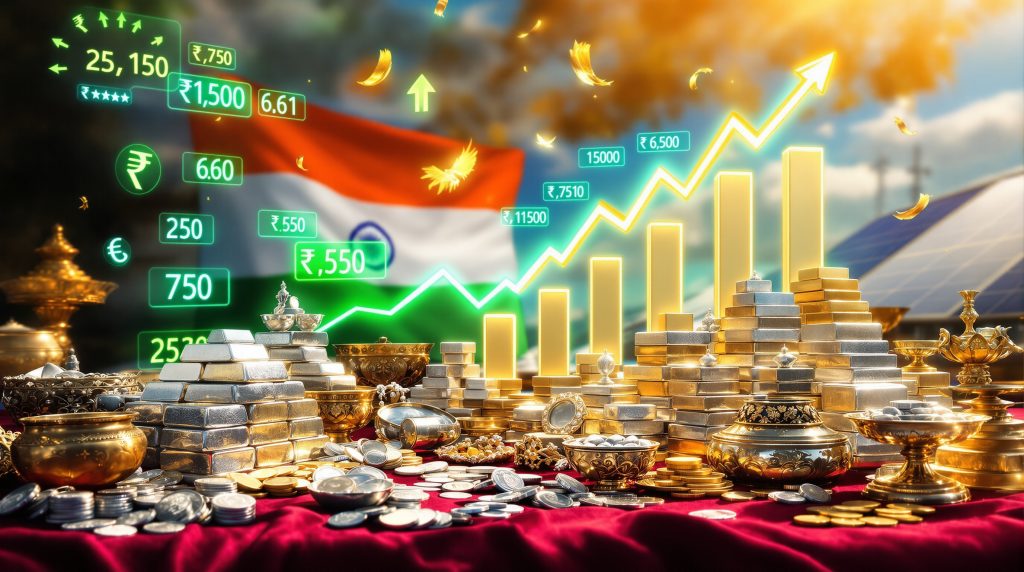Current Market Dynamics and Price Drivers
India's silver market has experienced remarkable momentum, with silver prices in India consistently trading above international benchmarks. This premium reflects a complex interplay of local demand patterns, supply constraints, and unique market dynamics that distinguish India from global silver trading centers.
Understanding India's Silver Price Premium
The price differential between Indian and international silver markets has widened significantly, with domestic rates often commanding premiums of 3-5% above London Metal Exchange quotations. Major trading hubs across India display varying price structures, with Mumbai typically setting benchmark rates due to its position as the country's primary precious metals trading center.
Regional price variations reflect local supply-demand imbalances and transportation costs. Delhi markets often trade at slight premiums to Mumbai due to higher logistics expenses, while Chennai and Kolkata prices incorporate additional regional factors including local jeweler preferences and festival timing differences.
Import duties significantly impact final consumer pricing, with current tariff impacts on silver adding substantial costs to international silver. The basic customs duty, combined with goods and services tax applications, creates a compound effect that amplifies price premiums for Indian consumers compared to global spot rates.
Festival Season Demand Surge
Cultural purchasing patterns drive distinctive seasonal demand cycles in India's silver market. Diwali preparations typically generate 40-60% increases in retail silver sales during October and November, as consumers purchase decorative items, religious artifacts, and gift articles. This concentrated buying period creates temporary supply shortages and price spikes.
Wedding season demands further intensify market pressures, particularly during auspicious calendar periods identified by traditional almanacs. Silver jewelry, utensils, and ceremonial items remain integral components of wedding preparations, with families often making substantial purchases months in advance to secure favorable pricing.
Consumer behavior analysis reveals silver's appeal as a more accessible alternative to gold during high price environments. When gold rates exceed psychological threshold levels, many buyers shift purchasing preferences toward silver, viewing it as offering similar cultural significance at more manageable price points.
What Factors Are Creating India's Silver Supply Shortage?
Import Dependencies and Global Market Pressures
India's silver consumption substantially exceeds domestic production capacity, necessitating significant import volumes to meet market demand. Monthly import data indicates India typically requires 150-200 million ounces annually to satisfy industrial and consumer requirements, making it one of the world's largest silver importing nations.
Primary supply sources include Australia, Mexico, and Peru, with established trading relationships facilitating regular shipment schedules. However, global supply chain disruptions and mining output variations in these regions directly impact Indian market availability and pricing stability. Furthermore, the silver market squeeze impact on global finance has created additional pressures on supply chains.
Currency exchange rate fluctuations add complexity to import cost calculations. Rupee depreciation against the US dollar immediately translates to higher landed costs for imported silver, as international transactions predominantly occur in dollar denominations. Import financing costs also fluctuate with global interest rate environments and credit availability conditions.
Industrial Demand Competition
India's expanding industrial sectors increasingly compete with traditional jewelry and investment demand for available silver supplies. Solar panel manufacturing has emerged as a significant consumption driver, with domestic production capacity growth requiring substantial silver inputs for photovoltaic cell production.
Electronics manufacturing growth creates additional industrial demand pressures. Circuit board production, electrical contacts, and conductive applications consume significant quantities of high-purity silver, with quality specifications often exceeding jewelry-grade requirements.
Medical and healthcare applications represent emerging demand categories, including antimicrobial treatments, medical device components, and pharmaceutical applications. These specialized uses typically command premium pricing due to stringent purity requirements and processing specifications.
Domestic Production Limitations
India's silver mining output remains limited compared to consumption requirements, with annual domestic production meeting approximately 10-15% of total market demand. Primary mining regions include Rajasthan, Karnataka, and Jharkhand, though ore grades and extraction economics limit expansion potential.
Infrastructure constraints impact mining efficiency and output optimization. Transportation networks, processing facilities, and technical expertise availability restrict the development of marginal deposits that might otherwise contribute to domestic supply augmentation.
Environmental regulations and permitting processes create additional barriers to production expansion. Mining operations must navigate complex approval procedures, environmental impact assessments, and community engagement requirements that can extend project development timelines significantly.
How Do Currency Fluctuations Impact Silver Pricing in India?
Rupee-Dollar Exchange Rate Effects
The correlation between USD/INR exchange rates and silver prices in India demonstrates strong statistical significance, with currency movements often amplifying precious metals price volatility. Historical analysis indicates that 1% rupee depreciation typically translates to 1.2-1.5% increases in domestic silver prices, reflecting the leverage effect of import dependencies.
Major importers employ various hedging strategies to manage currency risk exposure, including forward contracts, options strategies, and natural hedging through inventory management. However, smaller retailers and jewelers often lack access to sophisticated hedging instruments, making them more vulnerable to exchange rate volatility.
Future currency projections remain challenging given global economic uncertainties and monetary policy divergences between major economies. Reserve Bank of India interventions in foreign exchange markets can temporarily moderate volatility, but underlying structural factors continue influencing long-term exchange rate trends.
Inflation and Purchasing Power Considerations
Real price adjustments reveal the true cost impact of silver price increases on Indian consumers. While nominal prices may appear to rise dramatically, inflation-adjusted calculations provide more accurate assessments of purchasing power effects and affordability trends over time.
Comparative analysis with other precious metals indicates silver often outperforms gold during certain economic conditions, particularly when industrial demand growth exceeds jewelry demand growth rates. This performance differential influences consumer substitution patterns and investment allocation decisions.
Consumer behavior studies reveal threshold price levels where demand elasticity changes significantly. Beyond certain price points, discretionary silver purchases decline markedly, while essential cultural and religious purchases remain relatively insensitive to price variations.
What Investment Opportunities Exist in India's Silver Market?
Traditional vs Modern Investment Channels
Physical silver investment options encompass various forms, each offering distinct advantages and limitations. Silver coins and bars provide direct exposure to metal prices but require secure storage solutions and insurance coverage. Jewelry purchases combine investment characteristics with utility value, though craftsmanship premiums reduce pure investment efficiency.
Liquidity considerations vary significantly between physical forms. Standardised bars and recognised coins typically offer superior liquidity compared to custom jewelry pieces, with established dealer networks facilitating easier transactions. However, jewelry items may retain value through craftsmanship premiums that can offset metal price volatility.
Storage and security requirements create ongoing costs and logistical considerations for physical silver investors. Bank lockers, private vault services, and home storage each present different cost structures, security levels, and accessibility characteristics that investors must evaluate based on individual circumstances.
Financial Instrument Alternatives
Silver Exchange-Traded Funds (ETFs) have gained popularity among Indian investors seeking precious metals exposure without physical storage requirements. These instruments track silver price movements while providing stock market liquidity and professional fund management services.
Multi Commodity Exchange (MCX) silver futures offer leveraged exposure to silver price movements, enabling both speculation and hedging applications. Professional traders utilise these instruments for price discovery, risk management, and arbitrage opportunities between domestic and international markets.
Digital silver platforms represent emerging investment channels, allowing fractional ownership and systematic investment plan capabilities. These technology-driven solutions reduce minimum investment amounts and provide convenient transaction processing for smaller investors.
Portfolio Diversification Benefits
Silver's correlation characteristics with other asset classes create valuable diversification opportunities for Indian portfolios. Risk-adjusted return analysis indicates silver often provides superior performance during specific economic conditions, particularly during inflationary periods and currency devaluation scenarios.
Correlation studies reveal silver's relationship with Indian equity markets, fixed income securities, and real estate varies significantly across different time periods and market conditions. This varying correlation creates opportunities for portfolio optimisation and risk reduction through strategic allocation adjustments.
Optimal allocation recommendations depend on individual risk tolerance, investment horizons, and portfolio objectives. Conservative portfolios might allocate 5-10% to precious metals, while aggressive growth strategies could justify higher allocations during favourable market conditions.
How Are Retailers and Jewelers Adapting to Market Conditions?
Supply Chain Management Strategies
Inventory management has become increasingly complex for silver retailers facing volatile pricing and supply uncertainties. Working capital requirements have intensified as businesses must maintain adequate stock levels while managing price risk exposure and financing costs.
Supplier relationship dynamics have evolved toward longer-term partnerships and flexible contract arrangements. Volume commitments, price averaging mechanisms, and supply guarantee clauses help retailers secure reliable inventory sources while managing cost volatility. Additionally, understanding silver movement dynamics has become crucial for strategic planning.
Technology adoption for demand forecasting and inventory optimisation has accelerated among progressive retailers. Advanced analytics tools help predict seasonal demand patterns, optimise stock levels, and improve cash flow management through more accurate purchasing decisions.
Consumer Pricing Strategies
Price discovery mechanisms in local markets reflect complex interactions between global silver rates, local supply conditions, and competitive dynamics. Transparent pricing models that clearly link retail rates to benchmark indices help build consumer trust and facilitate more efficient price discovery.
Margin compression represents a significant challenge for retailers during volatile market conditions. Competitive pressures, inventory losses, and financing costs squeeze profitability, requiring careful balance between maintaining market share and preserving operational sustainability.
Customer education initiatives about price fluctuation factors, market dynamics, and timing considerations help consumers make more informed purchasing decisions while building loyalty through value-added advisory services. Retailers are particularly focusing on silver squeeze pricing strategies to help customers navigate market volatility.
Market Expansion Opportunities
Younger demographic segments display different purchasing behaviours and preferences compared to traditional silver buyers. Digital engagement, online purchasing, and investment-oriented approaches characterise millennial and Gen-Z consumer patterns, creating opportunities for innovative retail strategies.
Rural market penetration remains underdeveloped despite significant growth potential. Distribution network expansion, localised product offerings, and culturally sensitive marketing approaches could unlock substantial demand in tier-2 and tier-3 markets.
Online versus offline channel performance analysis reveals complementary rather than competitive dynamics, with digital platforms facilitating research and education while physical stores maintain importance for high-value transactions and customer relationship building.
What Are the Long-Term Price Projections for Silver in India?
Fundamental Analysis Factors
Global silver production capacity expansion timelines suggest supply constraints may persist for several years, supporting price stability at elevated levels. Major mining projects currently under development could increase global output by 15-20% over the next 3-5 years, though Indian demand growth may absorb much of this additional supply.
Indian consumption growth projections incorporate both traditional demand drivers and emerging industrial applications. Conservative estimates suggest 8-12% annual growth in total silver demand, driven by expanding middle-class populations, urbanisation trends, and industrial development initiatives.
Industrial demand evolution in key sectors presents both opportunities and challenges for price forecasting. Solar energy expansion, electronics manufacturing growth, and medical applications development could substantially increase industrial consumption, potentially creating supply-demand imbalances.
Economic Policy Impact Assessment
Government initiatives affecting precious metals trade include import duty modifications, tax policy changes, and regulatory framework updates that could significantly influence market dynamics. Recent policy discussions suggest potential adjustments to import tariff structures that could impact domestic pricing premiums.
Regulatory changes influencing import-export procedures, quality standards, and trading mechanisms may affect market efficiency and price discovery processes. Streamlined procedures could reduce transaction costs while enhanced quality controls might increase compliance expenses.
Tax policy modifications, particularly regarding GST rates and capital gains treatment, could influence investment demand patterns and overall market attractiveness for different investor categories. For instance, current silver rates in India are significantly impacted by these policy decisions.
Technical Analysis Perspectives
Historical price cycle analysis reveals recurring patterns in Indian silver markets that may provide guidance for future price movements. Seasonal variations, festival-driven demand surges, and global economic cycle correlations offer potential timing insights for market participants.
Support and resistance level identification through technical analysis methodologies suggests key price thresholds that may influence future trading ranges. These levels often coincide with psychological price points and historical trading volumes.
Seasonal trading patterns demonstrate reliable tendencies around major festivals, wedding seasons, and agricultural cycles. However, global economic disruptions and policy changes can override these traditional patterns, requiring adaptive analytical approaches. Furthermore, comprehensive silver crash recovery analysis suggests that market patterns may be evolving.
Risk Management Considerations
Volatility measurement indicates silver markets experience higher price fluctuations compared to gold, creating both opportunity and risk for market participants. Effective hedging strategies must account for correlation changes during stress periods and liquidity constraints during market disruptions.
Market manipulation concerns and regulatory oversight requirements emphasise the importance of transparent trading practices and robust market surveillance. Enhanced regulatory frameworks may improve market integrity while potentially increasing compliance costs.
Liquidity risk assessment across different investment vehicles reveals varying liquidity characteristics during normal and stressed market conditions. Physical silver, ETFs, and futures contracts each display different liquidity profiles that investors must consider in their risk management frameworks.
Strategic Investment Recommendations
Diversified investment approaches combining physical holdings and financial instruments offer optimal risk-return characteristics for most investors. This strategy provides direct metal exposure while maintaining liquidity and reducing storage-related risks and costs.
Timing strategies for market entry should consider seasonal demand patterns, global economic conditions, and currency trends rather than attempting precise market timing. Dollar-cost averaging approaches may prove more effective than concentrated timing-based investments.
Risk tolerance alignment requires careful consideration of individual financial circumstances, investment objectives, and time horizons. Conservative investors should emphasise capital preservation while growth-oriented investors might accept higher volatility for potentially superior returns.
Market Outlook Summary
Key catalysts likely to influence future price movements include global economic recovery patterns, industrial demand growth, and monetary policy developments. Supply chain normalisation and mining output expansion could moderate price pressures, while continued industrial demand growth may support elevated price levels.
Potential challenges include regulatory changes, currency volatility, and global economic disruptions that could create market uncertainty. However, India's structural demand growth and limited domestic production suggest continued import dependence and potential price premiums. Current silver price trends indicate this pattern is likely to continue.
Monitoring indicators for informed decision-making should encompass global silver prices, currency exchange rates, industrial demand indicators, and seasonal demand patterns. Regular assessment of these factors can help investors and market participants make more effective strategic decisions.
Disclaimer: This analysis is for informational purposes only and should not be considered as investment advice. Silver markets involve significant risks, and past performance does not guarantee future results. Investors should conduct their own research and consult with qualified financial advisors before making investment decisions.
Ready to Capitalise on India's Silver Market Opportunities?
Discovery Alert's proprietary Discovery IQ model delivers real-time alerts on significant ASX mineral discoveries, instantly empowering subscribers to identify actionable opportunities ahead of the broader market. Begin your 30-day free trial today and secure your market-leading advantage in precious metals and mining investments.




